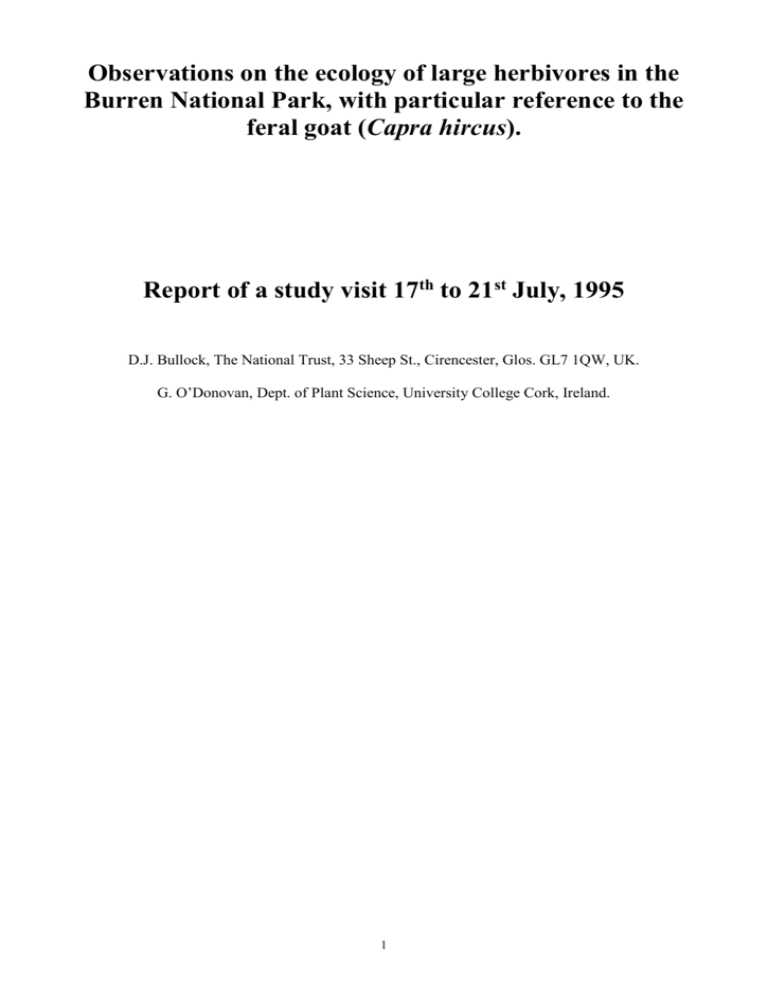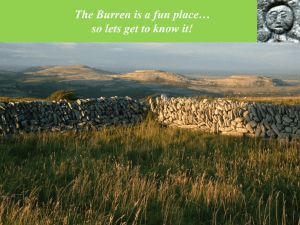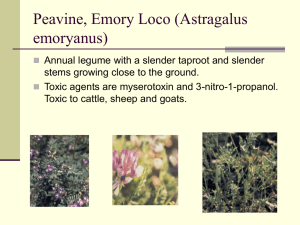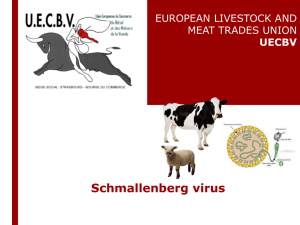Observations on the ecology of large herbivores in the
advertisement

Observations on the ecology of large herbivores in the Burren National Park, with particular reference to the feral goat (Capra hircus). Report of a study visit 17th to 21st July, 1995 D.J. Bullock, The National Trust, 33 Sheep St., Cirencester, Glos. GL7 1QW, UK. G. O’Donovan, Dept. of Plant Science, University College Cork, Ireland. 1 Background The karst landscape of the Burren, north-west Clare in the Republic of Ireland is well known for its unique flora and fauna. Cattle rearing is the predominant agricultural activity; suckler cows in calf are wintered on the higher limestone plateaux and pavements, to be brought down to lusher pastures in the spring. The winterage system has been in operation for centuries (Haughton 1953) and cattle have been the predominant livestock species for millennia. A study of nutrient turnover in these hills has shown that swards are productive over the autumn and winter period (O’Donovan 1987), and this, combined with the mild climate, partly explains why animals are over-wintered here. In addition to cattle, the Burren holds a large number of feral goats, the population being estimated in the low thousands (National Parks wardens pers. comm.). Feral goats remain on the Burren limestone all year, using a variety of terrestrial habitats depending on season and were, until recently, only sympatric with cattle between September and March. The Burren National Park (BNP) was officially designated in 1992. Between 1988 and 1994, the number of feral goats increased dramatically within the park (C. McGuire unpublished). The cause of the increase is unknown but several factors such as a relaxation of culling by local farmers, an increase in immigration (including escapees and releases of domestic stock) and favourable weather (especially during January/February when most kids are born and fat reserves in adults would be expected to be low) may have been responsible. In June 1994, the National Parks personnel responded to the population increase by culling 212 of the estimated 280 goats in the BNP (C. McGuire pers. comm.). A major influence on the decision to cull was the increased impact of the goats on the remaining tall scrub within the Park. In addition to the browsing and bark-stripping of established trees, the goats were believed to be reducing regeneration by browsing seedlings and saplings. Prior to the cull, the National Parks Dept. sought advice on feral goat management from, amongst others, DJB. It was suggested that management of the BNP would be well served by obtaining more information on the impact of the goat, cattle and other herbivores such as the hare (Lepus timidus), small mammals and invertebrates. The aim of this project was to make a start on gathering this information and to visit similar sites in the UK where goats were being used positively for conservation management. To achieve this, reciprocal visits were organised by the authors to the Burren and several National Trust properties where feral goats, feral sheep and rare breeds of livestock have been turned out on species-rich calcareous grassland in order to combat invasion by scrub. To more fully understand the role of goats within the BNP, discussions were held at the Park’s headquarters to access what information was currently available, and what data needed to be collected. Particular emphasis was placed on appraisal in the field of four monitoring plots (three of which were enclosures) which have been established in the BNP since 1980. These activities form the basis of this report and preliminary results are presented. The objectives of the Burren visit were: 2 1. To assess the past and present impact of goats and cattle in four key habitat types in the Burren landscape (following Moles & Travers 1981): i.e. tall scrub with trees; low scrub; limestone pavement with clints/rubble, and limestone grassland. 2. To critically appraise the monitoring plots as indicators of the impact of goats and cattle. 3. To discuss with the National Parks Dept. the significance of goats and cattle as a management tool for conservation in the BNP and the Burren as a whole. Approach Between the 17th and 21st July 1995, fieldwork was concentrated in the BNP, where the authors were joined by National Parks Ranger C. McGuire and UCC postgraduate student D. Byrne, who is studying the comparative nutritional ecology of goats and cattle there. We examined many of the existing exclosures (the three large ones, five of the ten small ones), and two of the five woodland monitoring plots. At the site of each we assessed which herbivore species were being excluded (e.g. cattle, goats, hares), habitat suitability for cattle and goats, and subjectively compared vegetation inside and outside in terms of plant species composition, structural diversity and the likely differences in invertebrate populations. In addition we made observations on the size and composition of goat groups both outside and inside the BNP. Results 1. Livestock in the Burren 1.1 The goat 1.1.1 Cultural and biological significance Very little research has been conducted on any aspect of the goat, especially the feral goat, in Ireland and much that has been written is either anecdotal or in unpublished reports of restricted availability (J.S. Fairley in litt,; Whilde 1984; Whitehead 1972). It is therefore appropriate to review the existing information as it relates to Burren. Bonham and Fairley (1984) described preliminary results of an ecological study of the feral and free-ranging goats on Mullach Mor in the BNP. This is the only published study of feral goats in Ireland that the authors are aware of. A review of the feral goat in northern Europe is in preparation by one of us (DJB) in which this information will be incorporated. The goat, together with the sheep, is poorly represented in faunal remains at archaeological sites in the Burren. For example, in the 9th century cliff at fort Cahercommaun, only one per cent of domestic animal bones were either sheep or goat (in D’Arcy and Hayward 1992). However, it seems likely that the latter has been an important component of the economy of the Burren since first brought there by Neolithic peoples. Not only does it provide milk products, and kid meat (kid meat is still traditional at Easter) but also a way of preventing scrub encroachment into pastures. All these uses of the goat appear to be current in the Burren. Indeed the feral goat is recognised in Ireland as an Endangered Rare Breed for which a headage payment can, theoretically, be claimed (DAFF 1992). 1.1.2 Population ecology 3 In northern Europe, the Burren is unique in holding a large population of feral and free-ranging goats, the distinction between which is often difficult to determine. Most of the goats we observed were in four mixed sex groups each containing at least 40 individuals, and large groups appear to be frequent in the Burren (C. McGuire pers. comm.). In south-west Scotland, the mean size of mixed sex groups in summer/autumn is considerably lower at between 20 and 25 (Bullock 1982). Amongst ungulates, group size tends to be larger in open compared with closed landscapes (Geist 1974), and although the hills of south-west Scotland would appear to be as open as the Burren karst, they are steeper and more topographically diverse. The flight distance (the distance at which an animal prepares to flee) of the Burren goats on pavement is long (c. 500m in one observation). It is much shorter for feral goats (irrespective of hunting pressure) in the southern Scottish hills where they have access to cliffs or broken ground (DJB pers. observ.). These observations, plus an indication that the adult sex ratio is close to unity (it is markedly skewed to females in all other populations studied in Britain and Ireland (Bullock 1991)), suggest that the population ecology of the Burren goats may differ from that of most other northern European populations. It would merit further management-orientated study. 1.2 Cattle Approximately 50,000 head of cattle are wintered in the Burren pavement and hills (D’Arcy unpublished 1995). Winterage has been assumed to reflect the long growing season, and the need to conserve the keep in the low-lying areas. However, a third component may be water. In winter when turloughs are flooded, and water is available on higher ground, cattle are moved uphill. In summer, water is not freely available in the uplands and cattle, which need to drink on a daily basis, may be unsuitable there. In contrast, in northern Europe, the feral goat rarely needs to drink and is well suited to environments with low water availability. In the Burren, as elsewhere, cattle are predominantly grazers (i.e. their diet consists mainly of grasses, rushes and sedges – D. Byrne unpub. observ.). The grazing by cattle on carboniferous limestone grasslands in the Yorkshire Dales in late summer and autumn is considered to be an important management tool for the maintenance of plant species richness (DJB pers observ.). It seems likely that cattle grazing is similarly important in the maintenance of the rich ground flora in the Burren. Sheep grazing of calcareous grasslands (especially in summer) may reduce nature conservation interests, and it is perhaps fortuitous that cattle rather than sheep have been the predominant livestock species in the Burren. In recent years, the number of cattle using the Burren has increased with concomitant increases in poaching and overgrazing (D’Arcy unpub. report 1995). A rogue herd was observed on the uplands during this visit. Summer grazing on the uplands could reduce the floristic diversity considerably, especially if at high stocking density and early in the season. Changes in cattle numbers in relation to the quality of the limestone grasslands has not, to our knowledge, been investigated. There is an urgent need to instigate such monitoring. 2. Exclosures and monitoring plots 2.1 Bonham/National Parks exclosures. In April 1980, F. Bonham, a postgraduate student under the auspices of the National Parks Dept., established two exclosures on the eastern slopes of Mullach Mor. Both consisted of metal posts supporting stock fencing c. 2.0m high which totally excludes all cattle and all but the most determined of goats, but neither hares nor small mammals. 2.1.1. Upper Exclosure 4 This is situated beneath a scar, part in woodland (Tall scrub with trees) and part extending out into limestone grassland (sward) on relatively deep soil (>100mm). The exclosure runs in an east-west and north-south direction for c. 30m and c. 12m respectively (Bates 1988). The control area is believed to have been the equivalent area immediately to the south but this needs to be confirmed. This exclosure is an area frequently used by cattle for shelter and feeding in the winter, and is thought to be used to some extent by goats all year round. There were clear differences between the inside and outside of this exclosure in both the tall scrub with trees and sward areas. In the former, where exclosed, the shaded ground layer vegetation was dominated by plant species indicative of long established woodland such as sanicle (Sanicula europaea), enchanter’s nightshade (Circaea lutetiana), wood melick (Melica uniflora), twayblade (Listera ovata), ramsons (Allium ursinum) and wood false brome (Brachypodium sylvaticum). Bryophytes were abundant, and there were possibly more molluscs here than in the control area. A small oval stone enclosure found within the wooded part of the exclosure harboured nettle (Urtica dioica). This indicates high nutrient enrichment from dunging, and the enclosure may have been originally located in grassland into which woodland has since encroached. Outside the exclosure, the ground layer in the wooded area contained much less sanicle, enchanters’s nightshade and wood false brome than inside, and more valerian (Valeriana officinalis), cocksfoot (Dactylis glomerata) and other more nutrient and light demanding species. There were strong differences between the sizes and numbers of hazel (Corylus avellana) stems inside and outside the exclosure. Inside, there was a greater amount of dead and dying wood, and medium to small stems. Outside, large girth old stems and small stems predominated producing a more strongly bimodal distribution of girths than within although this would need to be formally measured. It seems likely that the majority of small stems outside the exclosure will be bark-stripped and browsed this winter. Examination of the stools revealed how annual growth is frequently browsed back every year. In the grassland part of the exclosure, blue moor grass (Sesleria albicans) was rank and apparently overtopping low growing species such as mountain avens (Dryas octopetala). Bramble (Rubus fruticosus agg.) was only present within the exclosure mostly at the woodland-grassland interface. Hazel bushes in the grassland part of the exclosure were wider and taller than those outside but showed dead leaders. This phenomenon is believed to be due to exposure/windcheck and clearly indicates that large herbivores are only one factor influencing the distribution and abundance of hazel in the BNP. 2.1.2. Lower Exclosure This runs in a north-south and east-west direction for c. 33m and 20m respectively (Bates 1988) on sloping limestone pavement. There are clearly three strata with low scrub featuring in the middle and lower pavement parts. The control area is believed to be immediately to the north although this needs confirmation. This exclosure is in an area used predominantly by goats. Cattle frequent the upper terraces occasionally in winter; goats use the area the year round. Although not measured, it is clear that the area around the Lower Exclosure offers significantly less shelter than the Upper Exclosure. Within the exclosure, hazel bushes were of measurably greater width, height and density, but had a greater number of dead leaders that had been checked by either the wind or low water availability. The implication is that even in the absence of browsing by stock, hazel bushes on the upper scars and terraces of Mullach Mor and other hills on the karst are unlikely to develop beyond low scrub. In terms of the ground layer vegetation, there appeared to have been a greater density and cover of blue moor grass and a greater number of flowering and fruiting plants within the exclosure than in the presumed control outside. For example, a substantial proportion of flowering spikes of helleborines (Epipactis helleborine and, to a lesser extent, E. atrorubens) had been eaten off by livestock (not hares) outside the exclosure compared to the inside. Goats have been observed to eat helleborine 5 spikes elsewhere (Smith & Bullock 1993) and given the terrain and time of year, are most likely to have eaten the ones we observed. Removal of flowering and fruiting stems by grazing and browsing, combined with the apparent reduction in structural diversity could reduce invertebrate species diversity, and both factors may mean that the exclosures will act as a source of propagules for the adjacent grazed areas. 2.1.3 General observations on the Bonham/National Parks exclosures A combination of their age, sound construction and location means that the value of these exclosures increases over time. Every effort must be made to maintain them into the long term as a demonstration of the karst landscape in the absence of two livestock species with a major impact on vegetation. However, it is difficult to detect quantitative changes due to a lack of livestock because monitoring methods used since they were erected have apparently been inconsistent with the original one. Close examination of Bonham’s unpublished report (a copy of which is lodged with the BNP Superintendent’s Office in Corofin) revealed (for the first time since it was written?) detailed results of recording vegetation within and outside each of the exclosures. We are still attempting to decode some of the data, and it will probably be necessary to contact Bonham directly in order to do this with accuracy. Since 1980, two students (Bates, 1988 and D’Auria, date and title unknown) have monitored the plots. We have not as yet seen the latter. The former appears to use sampling methods that differ from those used by Bonham, and whilst of value in its own right, may have limited use in detecting change. We recommend that the vegetation is now measured using Bonham’s original method as a baseline to permit direct comparison, and that the measurements are expanded to include more details of the woody plant species (for example, height, girth, density, proportion of dead:live material and fruiting success). In addition, we suggest that the following should be compared; saproxylic (deadwood inhabiting) invertebrates and fungi, lichens, bryophytes, spiders, ground beetles and selected Diptera. At present it is only possible to infer the separate impact of goats and cattle by assuming that the Lower Exclosure is on terrain that the latter rarely uses. There is an urgent need to extend the present exclosures to include a comparable one which, by virtue of a lower (less than 1.0m) stock fence, is accessible to goats but not cattle. It is only through this experimental approach and associated studies (such as dietary and distributional overlap) that the nature of the interactions between goats, cattle and vegetation can be understood sufficiently for them to be used as a management tool. We therefore suggest that the number of Bonham/National Parks style exclosures is increased to include at least two other habitats: Tall scrub with trees in the woodland north-west of Loch Gealain, and limestone pavement. A final series of comparisons that we would suggest as useful relate to nutrient cycling. Decomposition rates and tissue turnover could be compared but a most interesting and illuminating study would be of the biota of solution cups in the presence and absence of dung. These areas are the subject of a research project by D. Byrne. However, we propose that this study is taken into the long term in order to understand more fully how large herbivores influence the establishment of plant communities on bare limestone rock. This would complement recent studies by R. Moles on the dynamics of vegetation patches on limestone pavement (Section 2.2). 2.2. Moles/National Parks Exclosure This is situated in a grassy hollow on limestone pavement north of Loch Gealain. It is triangular (c. 10m by c. 10m by c. 10m) and bounded by a stock fence c. 1.0m high that excludes cattle. It was established in 1989. A few goat (but no hare) droppings were found in the exclosure; this observation and examination of woody plant species indicated a low browsing pressure outside the growing season. 6 The relatively low elevation and sheltered location is probably responsible for the tallness of the hazel bushes relative to those on more exposed adjacent pavement. Within the exclosure, hazel appeared to be taller, denser and more freely fruiting than immediately outside. Several species appeared to have more luxuriant growth within the exclosure including spindle (Euonomys europaeus), holly (Ilex aquifolia) and heather (Calluna vulgaris). Hawthorn (Crataegus monogyna), whilst obviously browsed within the exclosure, was heavily browsed immediately outside indicating its high palatability compared with hazel. Within the ground layer of the exclosure, there was possibly more blue moor grass, hardhead (Centaurea nigra) and ladies bedstraw (Galium verum) and the sward seemed denser. In this exclosure it was difficult to separate out the sheltering effect of the hollow from the effects of large herbivores, particularly because goats do sometimes gain access. A pressing need, therefore, is to make the exclosure goat proof by increasing the height of the fence to the same as that of the Bonham/National Parks exclosures. This would allow a more confident comparison of the effects of large herbivores on soil loss and vegetation dynamics than is possible at present. 2.3. The National Parks Yew exclosures Situated mostly on low limestone pavement on the southern and eastern slopes of Mullach Mor, ten cages 1.0m x 1.0m x 0.7m were erected around heavily browsed yew (Taxus baccata) bushes in 1994. Their growth is being measured compared to uncaged bushes in the vicinity using fixed point photography. The objective is to establish mature yew trees on limestone pavement. Growth of caged individuals has been spectacularly greater than that of the controls. Whilst some this is due to a relaxation of browsing pressure, it seems likely that the cages are instrumental in creating a more sheltered and humid microclimate than immediately outside. We would suggest that whilst these exclosures have been useful in establishing the impact of browsing (and exposure?) on yew, this approach is rather piecemeal and lacks a clear rationale. A broader objective is needed for this project. If restoration of pavement woodland is the overall objective then a different prescription is needed. Larger exclosures to allow yew and a range of other woody plant species to develop (including spindle, purging and alder buckthorn (Rhamnus catharticus and Frangula alnus) may be judged of higher nature conservation significance. We note that according to D’Arcy and Hayward (1992) farmers selectively removed yew from limestone pavement in the Burren so that their cattle would not browse it and be poisoned. If control of yew is still practised by farmers, and we accept that winter cattle grazing is essential to maintain the nature conservation interests of the BNP, promotion of yew trees on pavement may be undesirable in the long term. 2.4 Monitoring plots in the Lough Gealain woodland Five 10.0m by 10.0m plots were established in this wood from 1991 onwards by C. McGuire (National Parks). The aim was to monitor tree performance in relation to bark-stripping. Two of these were visited in the present project. All the plots are in mature woodland where shade has a major influence on the ground layer vegetation. Our impression is that the work involved in marking and recording the performance of all the trees in each plot can only be justified if the objectives are broadened. The plots represent what appears to be the only opportunity in the Burren to record the dynamics of mature woodland. Initial tag marks on trees have been unsatisfactory. We recommend that all the repeated measurements need to match that of possible changes to the woodland and so should be in intervals of five years or more. It is essential that retagging the trees is accompanied by fixed point photography and accurate coordinates for locating the plots. In addition, the history of grazing the wood over the last century needs to be 7 researched. It will be very difficult to interpret the results of monitoring without knowledge of the past and present grazing regimes. Two examples will illustrate this need: 1. There was an abundance of tree seedlings in places beneath a shady canopy of hazel. We identified rowan (Sorbus aucuparia), hawthorn, guelder rose (Viburnum opulus), spindle and possibly elm (Ulmus) seedlings. Hazel dominates the canopy and before reaching sapling size, these seedlings are shaded out and/or browsed in winter. The former is more likely as there was no evidence of repeated browsing of the same plants. 2. Cursory examination of hazel stools within the wood revealed a clear bimodal distribution in the girths of stems. We estimated that the large, thick stems were in excess of 40 years old. The smaller girth stems were mostly less than 10 years old. It is these stems that had been recently barkstripped by goats. There were very few middle aged stems. There are three possible explanations for this distribution. First, barkstripping and browsing pressure by goats and cattle was sufficiently high for much of the last century for no stems to mature. Second, small stems are continually shaded out and killed by the canopy when they reach a certain girth. Third, hazel stems were harvested until fairly recently. Without access to detailed measurements of the age of the trees, data on the grazing regime and uses to which hazel was put by farmers over the last century, we cannot start to understand the dynamics of this woodland sufficiently such that clear objectives of management can be set. Since our visit we have received information on the history of use of the wood (C. McGuire in litt.) which corroborates the first and third explanations for the strongly bimodal distribution of girths of hazel stems. McGuire spoke to several local people and reported the following: ‘At the turn of the century, much hazel was harvested as scollops/rods for thatching, in fact many people saved their fare to America from this work. In the 1950 (s), the timber in the wood was cut and taken to a saw mill that was set up in the area. Heavy grazing by cattle occurred prior to 1960, but since this time it has remained more or less constant’. 2.5 Other monitoring plots Bates (1988) describes the establishment of 16 permanent quadrats in the BNP, in which the vegetation was measured in that year. We were not aware of these quadrats during our visit. Provided that they can be refound and measured using Bates’s method, their value in detecting vegetation change in relation to changes in cattle and goat numbers would be high. Summary 1. The cultural significance and past environmental impact of the goat in the Burren must be considered in any current management plan. More information is needed on the historical and present day uses of the goat in the local economy. The Burren is unique in northern Europe in holding an exceptionally large population of goats, with frequent interchange between feral and domestic stock. This provides an unusual opportunity to study the biology (including the genetics) of a livestock species as it adopts a wild or domestic existence. 2. Winter grazing by cattle in the Burren uplands (winterage, some of which is in the booleying system) is probably very important in the maintenance of high plant species richness. Recent increases in cattle numbers and changes in the grazing regimes are likely to be detrimental to the 8 ground layer flora. The adverse impact of cattle on the flora of the Burren may be much greater than that of the feral goat. 3. Four sets of exclosures/monitoring plots in the BNP were examined in July 1995. The two Bonham/National Parks exclosures are very much the oldest. They were designed to show the impact of cattle and goats and their value as demonstration sites increases annually. However, their potential for improving our understanding of the role of large herbivores in the conservation of the Burren has not been fully realised. The exclosures should be monitored using methods originally described by Bonham, and the exclosures should be extended to include goat-only treatments and a greater number of vegetation types. The Moles/National Parks exclosure was erected to investigate patch dynamics and the effects of large herbivores on pavement vegetation. It is cattle proof and acts as a partial deterrent to goats. This has allowed an insight into the browsing preferences of the latter, but will not allow a valid comparison of vegetation dynamics in the presence and absence of large herbivores. It would, therefore, be appropriate to make this exclosure goat proof. The ten cages erected on pavement to protect yews are useful as demonstrations of the impact of goats/cattle and exposure on performance of individual trees, but we would suggest this project lacks a clear objective in that partial, highly selective, restoration of woodland on pavement is being achieved. The five plots within the Lough Gealain woodland, set up to monitor the impact of large herbivores on individual trees, will increase in value annually provided that the trees are properly tagged, and the scope of measurements broadened. Similarly, the 16 permanent quadrats established by Bates in 1988 (which we did not see) could provide useful data on vegetation change in relation to grazing pressure over the last decade. Finally, we suggest that for management of the feral goats (and cattle) in the BNP, it would be appropriate to prepare a management plan. This could, ultimately, be integrated into a larger one for the Burren as a whole. Acknowledgements We are grateful to the British Council/An Forbairt in Dublin for a grant to support this study, and The National Trust (UK) for permitting DJB to visit Ireland. C. McGuire, Park Ranger Burren BNP, and D. Byrne kindly made time to show us some of their respective projects within the BNP and contributed to many stimulating discussions. References Bates, M.A. 1998. A review of the management and its effect on the vegetation in the Burren National Park, Co. Clare. Unpublished report to the Office of Public Works (National Parks and Monuments Branch). Bonham, F. & Fairley, J.S. 1984. Observations on a herd of feral goats (Capra domestic) in the Burren. Irish Naturalists Journal 21: 208-211. 9 Bullock, D.J. 1982. Aspects of the ecology of the feral goat (Capra (domestic)) in the Southern Uplands Ph. D. Thesis, University of Durham. Bullock, D.J. 1991. Feral goat. In The Handbook of British Mammals. Ed. Corbet, G.S. & Harris, S. 3rd. Edition. Blackwell Scientific Publications, Oxford. D’Arcy, G. 1995. The Burren as a grazed habitat: An historical overview. Unpublished report. D’Arcy, G. & Hayward, J. 1992. The Natural History of the Burren. Immel. London. Department of Agriculture, Fisheries and Food (DAFF) 1992. Rural Environmental Protection Scheme. EEC No. 2078/92. Dublin. Geist, V. 1974. On the relationships of social evolution and ecology in ungulates. American Zoologist. 14: 205-220. Haughton 1953. Land use of the Carran Polje. Irish Geography 2:225-226. Moles, R. & Breen, J. 1991. Surveillance of recent vegetation change in the Burren, County Clare, Republic of Ireland. Global Ecology and Biogeography Letters. 1:151-156. Moles, R. and Travers, I. 1981. Mullach Mor Habitat Map. Office of Public Works. Dublin. O’Donovan, G. 1987. An ecosystem study of grasslands in the Burren National Park, Co. Clare. Ph.D. Thesis. University of Dublin (Trinity College). Smith, J.E. & Bullock, D.J. 1993. A note on the summer feeding behaviour and habitat use of freeranging goats (Capra) in the Cheddar Gorge SSSI. Journal of Zoology, London. 231: 683-688. Whilde, T. 1984. Feral goats. Field and Countryside. 1: 28-29. Whitehead, G.K. The wild goats of Great Britain and Ireland. David & Charles. Newton Abbot. 10








